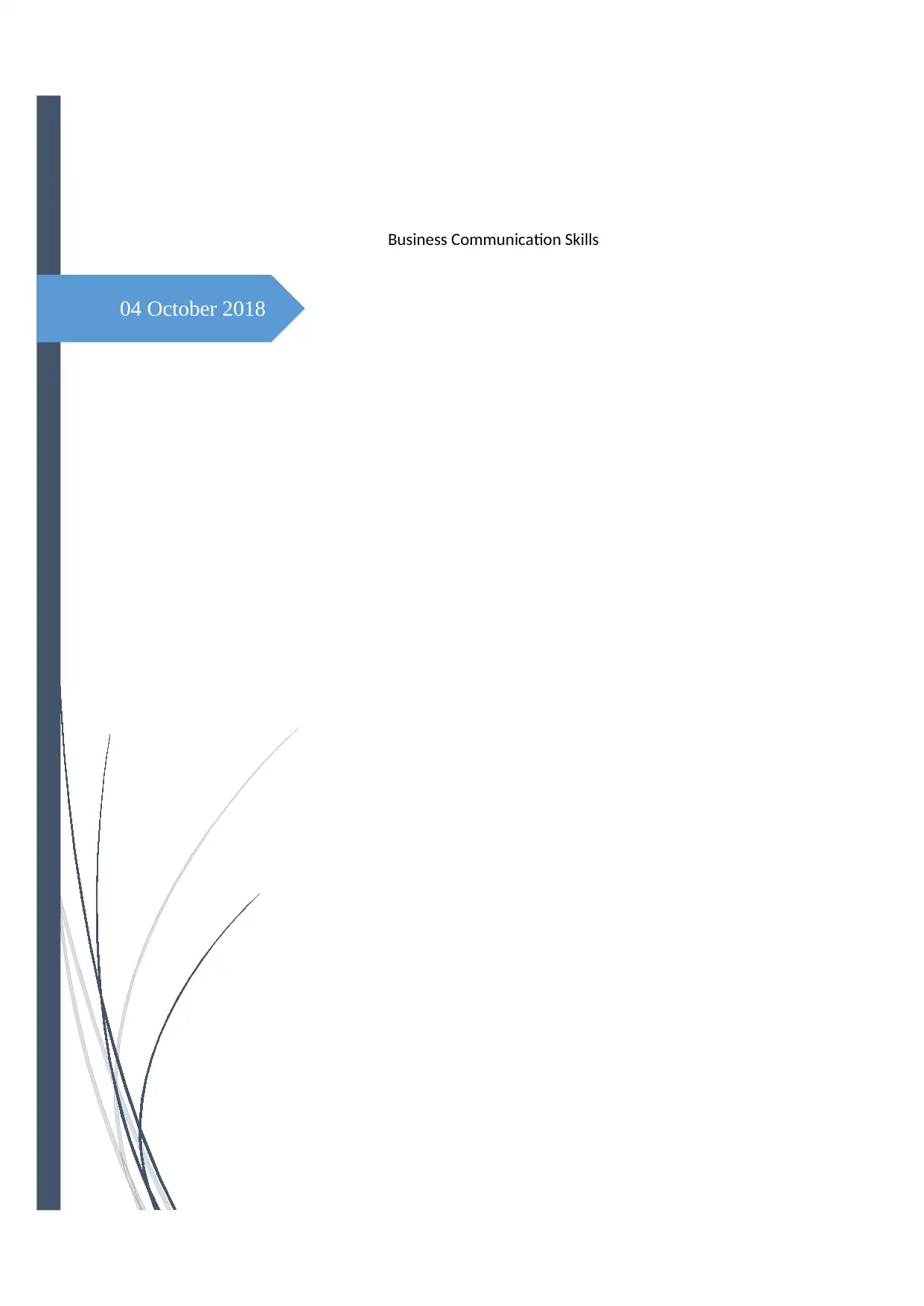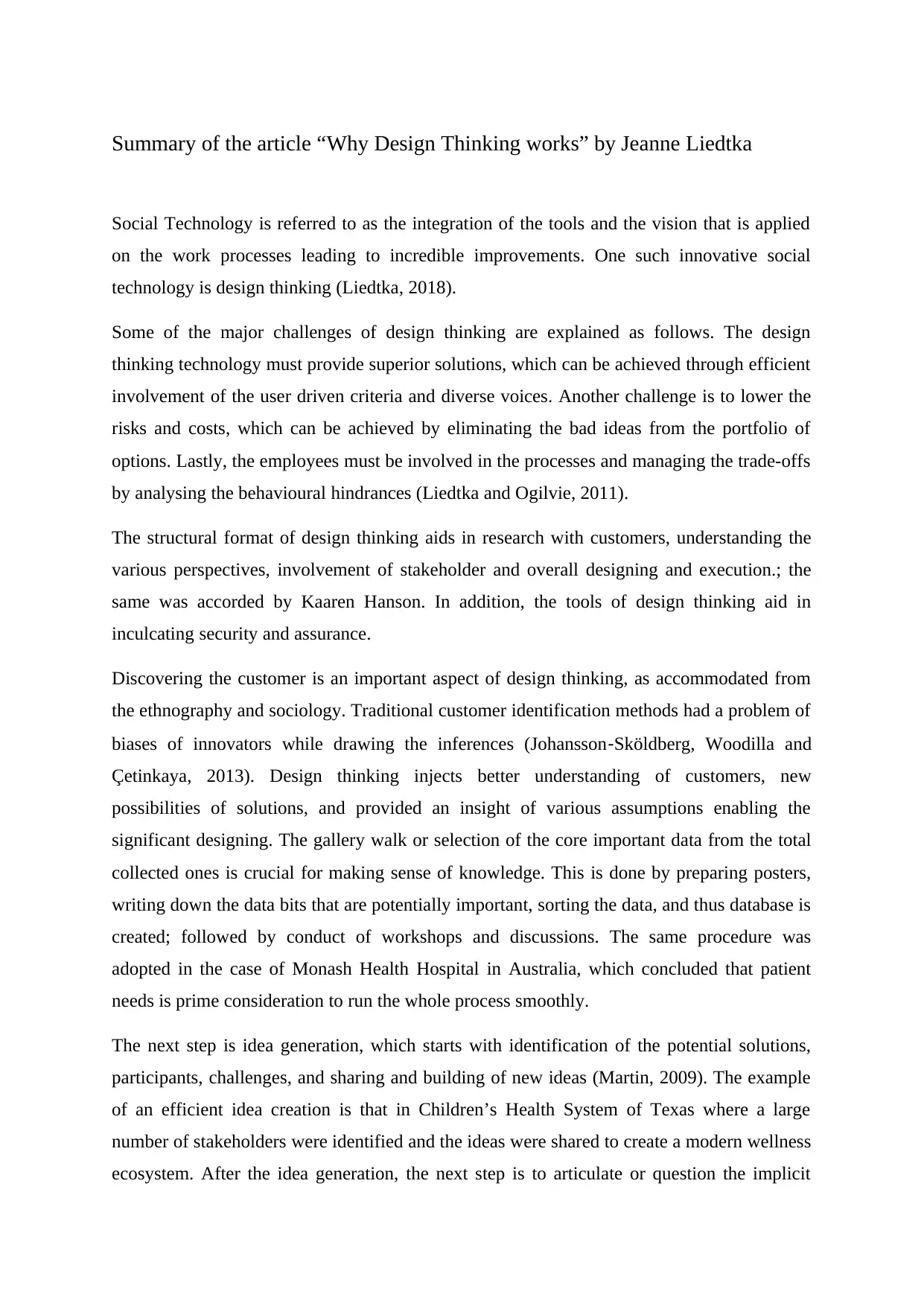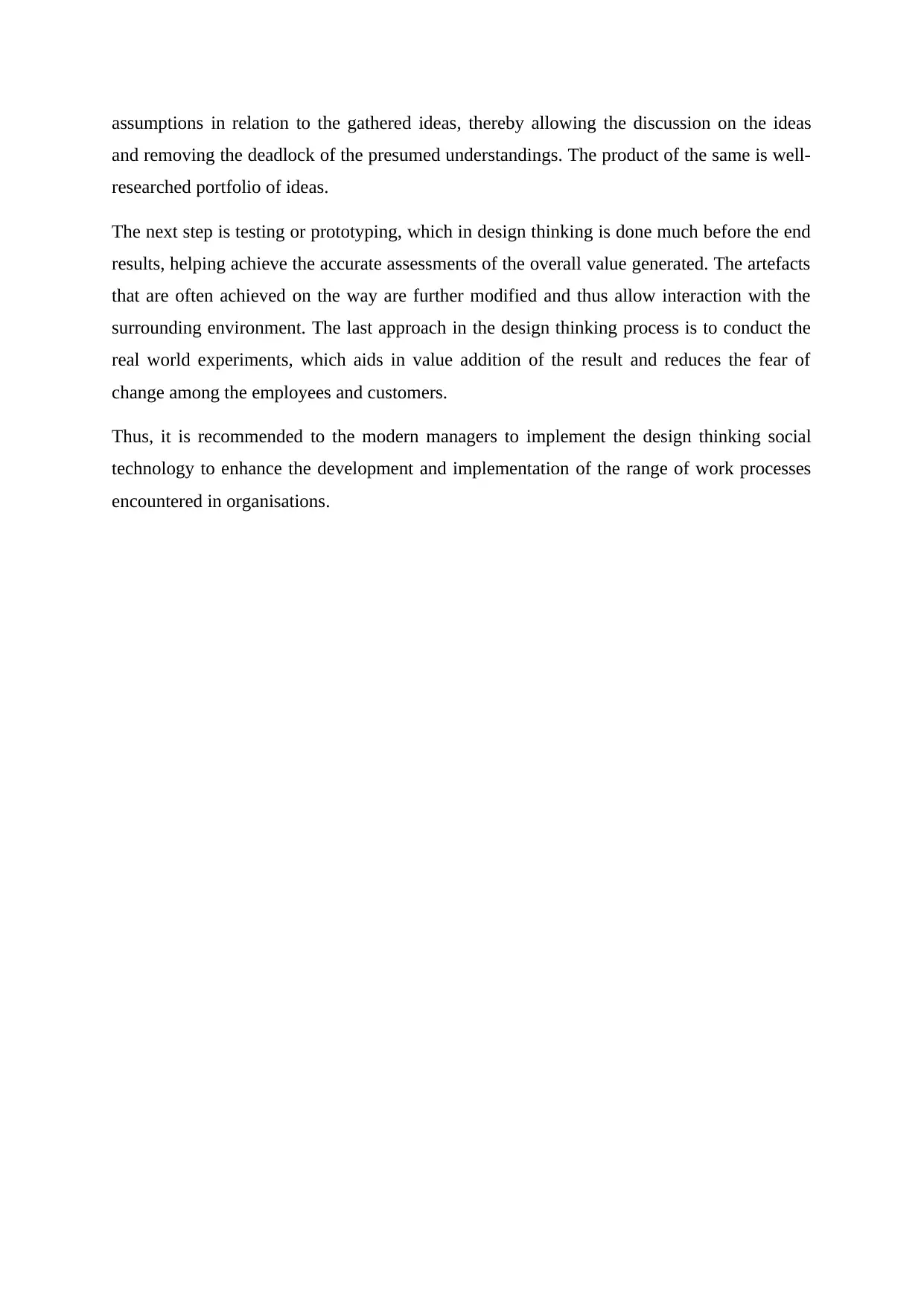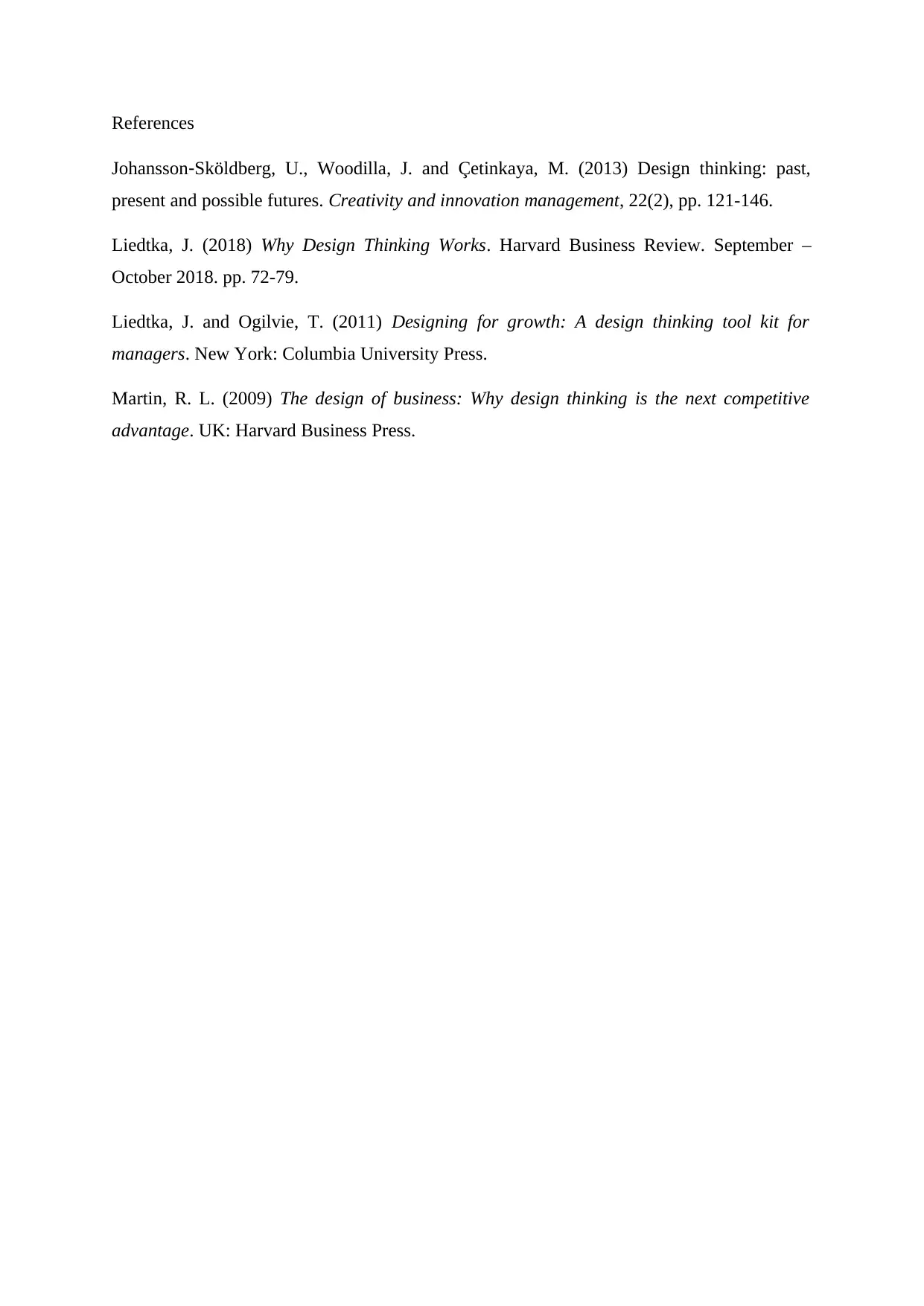Business Communication Report: Analysis of 'Why Design Thinking Works'
VerifiedAdded on 2023/06/04
|4
|714
|342
Report
AI Summary
This report summarizes Jeanne Liedtka's article, 'Why Design Thinking Works,' highlighting design thinking as an innovative social technology crucial for business improvements. The summary discusses challenges such as providing superior solutions, reducing risks, and involving employees. It expl...

04 October 2018
Business Communication Skills
Business Communication Skills
Paraphrase This Document
Need a fresh take? Get an instant paraphrase of this document with our AI Paraphraser

Summary of the article “Why Design Thinking works” by Jeanne Liedtka
Social Technology is referred to as the integration of the tools and the vision that is applied
on the work processes leading to incredible improvements. One such innovative social
technology is design thinking (Liedtka, 2018).
Some of the major challenges of design thinking are explained as follows. The design
thinking technology must provide superior solutions, which can be achieved through efficient
involvement of the user driven criteria and diverse voices. Another challenge is to lower the
risks and costs, which can be achieved by eliminating the bad ideas from the portfolio of
options. Lastly, the employees must be involved in the processes and managing the trade-offs
by analysing the behavioural hindrances (Liedtka and Ogilvie, 2011).
The structural format of design thinking aids in research with customers, understanding the
various perspectives, involvement of stakeholder and overall designing and execution.; the
same was accorded by Kaaren Hanson. In addition, the tools of design thinking aid in
inculcating security and assurance.
Discovering the customer is an important aspect of design thinking, as accommodated from
the ethnography and sociology. Traditional customer identification methods had a problem of
biases of innovators while drawing the inferences (Johansson‐Sköldberg, Woodilla and
Çetinkaya, 2013). Design thinking injects better understanding of customers, new
possibilities of solutions, and provided an insight of various assumptions enabling the
significant designing. The gallery walk or selection of the core important data from the total
collected ones is crucial for making sense of knowledge. This is done by preparing posters,
writing down the data bits that are potentially important, sorting the data, and thus database is
created; followed by conduct of workshops and discussions. The same procedure was
adopted in the case of Monash Health Hospital in Australia, which concluded that patient
needs is prime consideration to run the whole process smoothly.
The next step is idea generation, which starts with identification of the potential solutions,
participants, challenges, and sharing and building of new ideas (Martin, 2009). The example
of an efficient idea creation is that in Children’s Health System of Texas where a large
number of stakeholders were identified and the ideas were shared to create a modern wellness
ecosystem. After the idea generation, the next step is to articulate or question the implicit
Social Technology is referred to as the integration of the tools and the vision that is applied
on the work processes leading to incredible improvements. One such innovative social
technology is design thinking (Liedtka, 2018).
Some of the major challenges of design thinking are explained as follows. The design
thinking technology must provide superior solutions, which can be achieved through efficient
involvement of the user driven criteria and diverse voices. Another challenge is to lower the
risks and costs, which can be achieved by eliminating the bad ideas from the portfolio of
options. Lastly, the employees must be involved in the processes and managing the trade-offs
by analysing the behavioural hindrances (Liedtka and Ogilvie, 2011).
The structural format of design thinking aids in research with customers, understanding the
various perspectives, involvement of stakeholder and overall designing and execution.; the
same was accorded by Kaaren Hanson. In addition, the tools of design thinking aid in
inculcating security and assurance.
Discovering the customer is an important aspect of design thinking, as accommodated from
the ethnography and sociology. Traditional customer identification methods had a problem of
biases of innovators while drawing the inferences (Johansson‐Sköldberg, Woodilla and
Çetinkaya, 2013). Design thinking injects better understanding of customers, new
possibilities of solutions, and provided an insight of various assumptions enabling the
significant designing. The gallery walk or selection of the core important data from the total
collected ones is crucial for making sense of knowledge. This is done by preparing posters,
writing down the data bits that are potentially important, sorting the data, and thus database is
created; followed by conduct of workshops and discussions. The same procedure was
adopted in the case of Monash Health Hospital in Australia, which concluded that patient
needs is prime consideration to run the whole process smoothly.
The next step is idea generation, which starts with identification of the potential solutions,
participants, challenges, and sharing and building of new ideas (Martin, 2009). The example
of an efficient idea creation is that in Children’s Health System of Texas where a large
number of stakeholders were identified and the ideas were shared to create a modern wellness
ecosystem. After the idea generation, the next step is to articulate or question the implicit

assumptions in relation to the gathered ideas, thereby allowing the discussion on the ideas
and removing the deadlock of the presumed understandings. The product of the same is well-
researched portfolio of ideas.
The next step is testing or prototyping, which in design thinking is done much before the end
results, helping achieve the accurate assessments of the overall value generated. The artefacts
that are often achieved on the way are further modified and thus allow interaction with the
surrounding environment. The last approach in the design thinking process is to conduct the
real world experiments, which aids in value addition of the result and reduces the fear of
change among the employees and customers.
Thus, it is recommended to the modern managers to implement the design thinking social
technology to enhance the development and implementation of the range of work processes
encountered in organisations.
and removing the deadlock of the presumed understandings. The product of the same is well-
researched portfolio of ideas.
The next step is testing or prototyping, which in design thinking is done much before the end
results, helping achieve the accurate assessments of the overall value generated. The artefacts
that are often achieved on the way are further modified and thus allow interaction with the
surrounding environment. The last approach in the design thinking process is to conduct the
real world experiments, which aids in value addition of the result and reduces the fear of
change among the employees and customers.
Thus, it is recommended to the modern managers to implement the design thinking social
technology to enhance the development and implementation of the range of work processes
encountered in organisations.
⊘ This is a preview!⊘
Do you want full access?
Subscribe today to unlock all pages.

Trusted by 1+ million students worldwide

References
Johansson‐Sköldberg, U., Woodilla, J. and Çetinkaya, M. (2013) Design thinking: past,
present and possible futures. Creativity and innovation management, 22(2), pp. 121-146.
Liedtka, J. (2018) Why Design Thinking Works. Harvard Business Review. September –
October 2018. pp. 72-79.
Liedtka, J. and Ogilvie, T. (2011) Designing for growth: A design thinking tool kit for
managers. New York: Columbia University Press.
Martin, R. L. (2009) The design of business: Why design thinking is the next competitive
advantage. UK: Harvard Business Press.
Johansson‐Sköldberg, U., Woodilla, J. and Çetinkaya, M. (2013) Design thinking: past,
present and possible futures. Creativity and innovation management, 22(2), pp. 121-146.
Liedtka, J. (2018) Why Design Thinking Works. Harvard Business Review. September –
October 2018. pp. 72-79.
Liedtka, J. and Ogilvie, T. (2011) Designing for growth: A design thinking tool kit for
managers. New York: Columbia University Press.
Martin, R. L. (2009) The design of business: Why design thinking is the next competitive
advantage. UK: Harvard Business Press.
1 out of 4
Related Documents
Your All-in-One AI-Powered Toolkit for Academic Success.
+13062052269
info@desklib.com
Available 24*7 on WhatsApp / Email
![[object Object]](/_next/static/media/star-bottom.7253800d.svg)
Unlock your academic potential
© 2024 | Zucol Services PVT LTD | All rights reserved.





